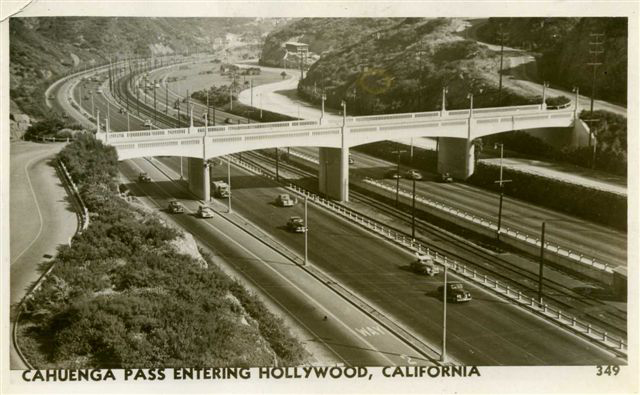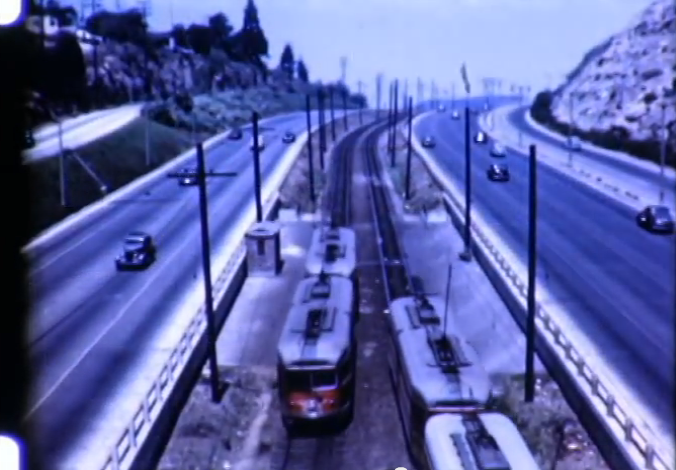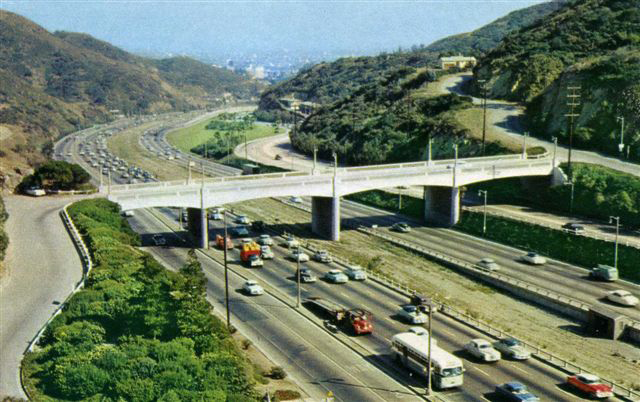Pacific Electric Tracks in the Hollywood Freeway: A Missed Opportunity
By Ralph Cantos
The postcard images depicted here show the Cahuenga Pass over a 45-year span.
The image above shows the Pacific Electric’s car tracks in the center of the then-called “Hollywood – Cahuenga Park Way”. This section of “Park-way” officially opened for traffic (both rail and automotive) on June 15, 1940, just a few months after the grand opening of the Arroyo Seco Parkway (now the 110 Freeway to Pasadena). This section of the Park-Way was given national media attention as the “Way of the Future” — that is, integrating rail rapid transit into new highway construction. Indeed, even the General Electric Company staged a filmed meet using two 2-car trains of PE PCCs rolling through the Pass. The short segment was used in a GE promotional film “Lifestream of The City,” which is embedded below. It was a proud time for both the PE and GE.
Advance to 9:45 to see the Cahuenga Pass PCC meet as described by the author
In 1940, the PE was still very much a “rail-oriented” company. PE management lobbied city, state and highway officials to consider integrating the PE rails into the ever-expanding Hollywood Freeway as it was extended towards Downtown LA. It was hoped the the PE rails would be included into new freeway construction. PE offered plans whereby the PE rails would be incorporated into the center of the new freeway. The rails would leave the freeway at Glendale Boulevard via an underpass and head directly to the Subway Terminal. It would have been fantastic convince for LA commuters.
But always, it was not to be. There was no way in hell that the powers then in charge of highway and freeway planning and construction would include a privately owned corporate rail line down the center of a freeway paid for by taxpayer dollars. It did not matter that the PE paid hundreds of thousands of tax dollars annually just to operate their system. The only reason that PE rails were placed down the center of the Cahuenga Pass was the fact that the PE rails was there long before anyone thought of the Park-Way. Let’s hope that the PE did not have to cough up any money for the relocation of their rails.
After World War II, most big US cities began to look at rail transit (city-suburban and interurban) as nothing more than an albatross, impeding highway construction. Private automobiles traveling on multi-lane highways through the urban landscape was the way of the future. City governments across this nation promised an “Automotive Utopia” for all Americans to enjoy.
And now, more than a half-century later, most US “Automotive Utopias” have turned into “Automotive Quagmires” … Hell on wheels. And now as America moves into the 21st Century, rail rapid transit has suddenly become the “in thing”, too late for the PE, but better late than never….
Ralph Cantos Collection
After little more than 12 years in service, the rail service through the Pass was abandoned. This 1955 photo shows the abandoned PE right-of-way. The waiting shelter in the center of the freeway was reached via a pedestrian subway from Caheunga Blvd west. It was sealed up after abandonment. It is possible that it still remains intact today, though plugged at both ends.
PE’s right-of-way as after erasure…gone and for the most part, forgotten.
-
[…] As part of a day long fan trip using Pacific Electric PCC no. 5011 on October 12, 1952, the 5011 made a trip over the Cahuenga Pass, the first time a PE PCC made the run over the pass since 1946 when scenes for the General Electric promotional film "Life Stream Of The City" were filmed. […]
Leave a Comment






It would be good to have the 1940 service again, it was before I was born
But we must remember, the days of fading electric railway service were also when motorists could “fill ‘er up” and get change from a 5-dollar bill, and one could buy a usable car for $100 or so. And imagine the uproar if a government entity proposed jacking up the gasoline tax to pay for transit improvements. PE was part of the Southern Pacific empire, and in the 1940s, some of the older folks remembered when SP was called “The Octopus” because at one time it had its “tentacles” in all aspects of state government.
Ralph Cantos does it again. Thanks for documenting our history with historic photos and film. How did you find the GE footage?
Wonderful document. Thank you again Ralph. 🙂
Dave Coscia’s book, “Pacific Electric and the Growth of the San Fernando Valley” contains some anecdotes regarding the slowness of service on the PE line between LA and Van Nuys. Even with the fast 800 class, the time between these two points was just under one hour. The anecdote describes an agonizingly slow trip into LA due to having to follow a slower city car as the 800 had to move along the trackage between Hollywood and Subway Terminal. Had PE been allowed to install tracks along the Hollywood Freeway between Hollywood Bowl, it is likely that 15 minutes could have been subtracted from the schedules. Faster trips could have made these lines much more attractive to commuters and might have enabled them to survive. Having to share Santa Monica BLvd and Sunset with several other local really slowed down service.
The GE promo film also includes Key System bridge units, an Electroliner and an LATL PCC.
When driving north under the Barham Blvd bridge in the left lane, the rusted bolt that supported the PE overhead is still visible.
Hi Ralph, the underpass at Mulholland Highway remained open into the 1990s. As you point out, however, the waiting shelters in the middle had already been sealed off. In the late years the underpass was well-inhabited by homeless people (not unlike the current passgeway that you have to take if walking south on Cahuenga Blvd. to the Hollywood Bowl). Sometimes when I took the bus home at night, it was scary crossing under the freeway. I would use the Mulholland Highway overpass instead. The east and west stairways entering the underpass were finally sealed up in the 1990s and you can scarcely see where the entrances once were.
It also shows scenes in my hometown, including Market-Frankford Elevated trains at both alongside 30th Street Station(which went underground in 1955), and on its Frankford Elevated section on Front Street(this section was relocated to the median of Interstate 95 in 1977), with the 1946 version of the Philadelphia skyline in the background…many new buildings have joined the imcumbents. The trains seen predated 1914, but lasted until 1961. Also, there’s a scene of PCC’s on Chestnut Street at Broad Street(a 1956 casualty of National City Lines), and Ridge Avenue’s Route 61 ETB(allowed by NCL to deteriorate and it became a 1961 victim). For my Boston friends, there’s a scene of 2-car PCC trains of “Wartime” cars, new in the scene shown.
The “rubber tire mafia” kills more rail related transportation modes, plus stupid, greedy politicians in their hip pockets.